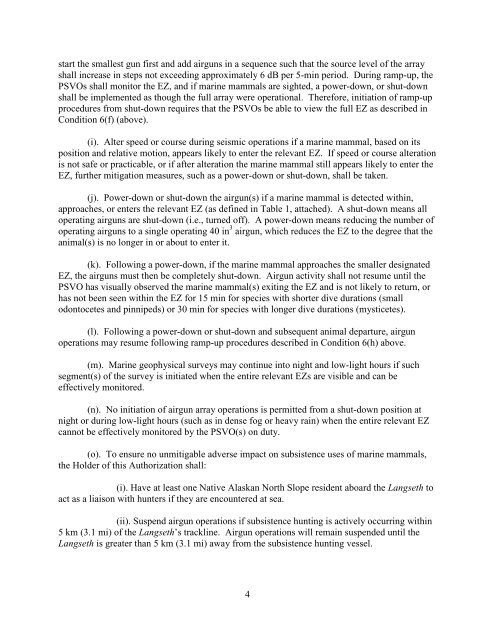90-day Monitoring Report - National Marine Fisheries Service - NOAA
90-day Monitoring Report - National Marine Fisheries Service - NOAA
90-day Monitoring Report - National Marine Fisheries Service - NOAA
You also want an ePaper? Increase the reach of your titles
YUMPU automatically turns print PDFs into web optimized ePapers that Google loves.
start the smallest gun first and add airguns in a sequence such that the source level of the array<br />
shall increase in steps not exceeding approximately 6 dB per 5-min period. During ramp-up, the<br />
PSVOs shall monitor the EZ, and if marine mammals are sighted, a power-down, or shut-down<br />
shall be implemented as though the full array were operational. Therefore, initiation of ramp-up<br />
procedures from shut-down requires that the PSVOs be able to view the full EZ as described in<br />
Condition 6(f) (above).<br />
(i). Alter speed or course during seismic operations if a marine mammal, based on its<br />
position and relative motion, appears likely to enter the relevant EZ. If speed or course alteration<br />
is not safe or practicable, or if after alteration the marine mammal still appears likely to enter the<br />
EZ, further mitigation measures, such as a power-down or shut-down, shall be taken.<br />
(j). Power-down or shut-down the airgun(s) if a marine mammal is detected within,<br />
approaches, or enters the relevant EZ (as defined in Table 1, attached). A shut-down means all<br />
operating airguns are shut-down (i.e., turned off). A power-down means reducing the number of<br />
operating airguns to a single operating 40 in 3 airgun, which reduces the EZ to the degree that the<br />
animal(s) is no longer in or about to enter it.<br />
(k). Following a power-down, if the marine mammal approaches the smaller designated<br />
EZ, the airguns must then be completely shut-down. Airgun activity shall not resume until the<br />
PSVO has visually observed the marine mammal(s) exiting the EZ and is not likely to return, or<br />
has not been seen within the EZ for 15 min for species with shorter dive durations (small<br />
odontocetes and pinnipeds) or 30 min for species with longer dive durations (mysticetes).<br />
(l). Following a power-down or shut-down and subsequent animal departure, airgun<br />
operations may resume following ramp-up procedures described in Condition 6(h) above.<br />
(m). <strong>Marine</strong> geophysical surveys may continue into night and low-light hours if such<br />
segment(s) of the survey is initiated when the entire relevant EZs are visible and can be<br />
effectively monitored.<br />
(n). No initiation of airgun array operations is permitted from a shut-down position at<br />
night or during low-light hours (such as in dense fog or heavy rain) when the entire relevant EZ<br />
cannot be effectively monitored by the PSVO(s) on duty.<br />
(o). To ensure no unmitigable adverse impact on subsistence uses of marine mammals,<br />
the Holder of this Authorization shall:<br />
(i). Have at least one Native Alaskan North Slope resident aboard the Langseth to<br />
act as a liaison with hunters if they are encountered at sea.<br />
(ii). Suspend airgun operations if subsistence hunting is actively occurring within<br />
5 km (3.1 mi) of the Langseth’s trackline. Airgun operations will remain suspended until the<br />
Langseth is greater than 5 km (3.1 mi) away from the subsistence hunting vessel.<br />
4
















